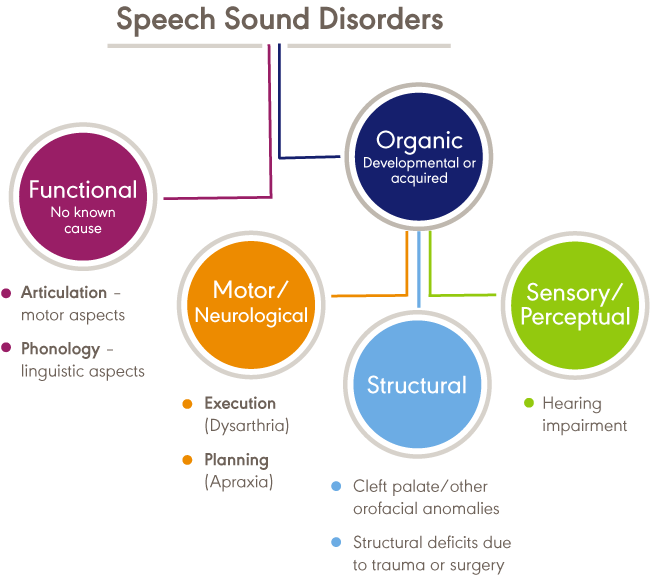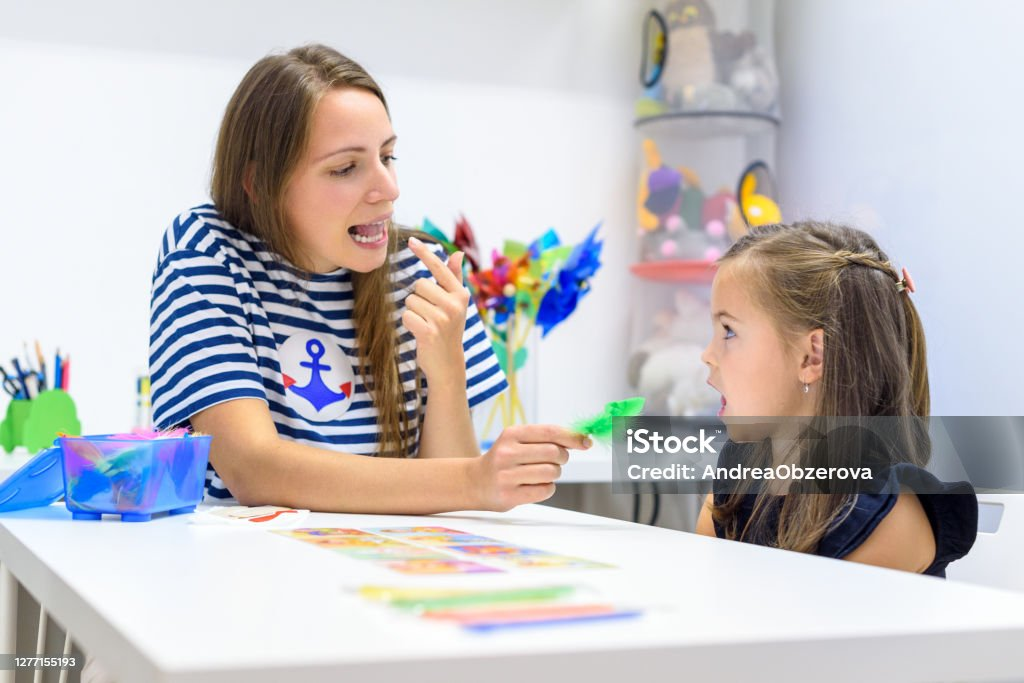Speech Sound Disorders: Articulation and Phonology
Speech sounds develop in a predictable order throughout childhood and by around age 4 most children’s speech can be understood by unfamiliar adults. A child who does not make all speech sounds or who cannot be understood by others by the time they are entering school may have a speech sound disorder. Often the cause of these disorders is unknown, and they are explained as "functional speech disorders". When we understand what caused the disorder, we refer to it as an "organic speech disorder". Causes of organic speech sound disorders can include conditions that children are born with such as cleft lip/palate and/or difficulties with hearing.

Articulation refers to the way sounds are made using the lips, jaw, tongue, palate, and vocal cords. An articulation impairment will result in sound omissions, additions, substitutions, and/or distortions such as extra air escaping from the front or sides of the mouth when producing an /s/ (also known as a lisp) or where the /w/ is substituted for the /r/ as in the word, “wabbit” for “rabbit”.

Phonology refers to predictable patterns or rule-based errors in speech and usually applies to more than one sound. Fronting is one example of a phonological process where several sounds are made at the front of the mouth, a child will say “tea” instead of “key” and “tan” instead of “can”. These impairments can make it difficult to understand what a child says because one small sound change can change the whole meaning of the word! This is known as a minimal pair when changing one sound results in a new word. For example, "fee" and "see" are minimal pairs.
To investigate a student's speech sound and/or phonology skills the SLP may complete an oral motor exam looking at the structure and function of the muscles used for speech, review the child’s hearing ability, and ask the child to say various words specifically chosen to represent the 44 phonemes (sounds) in English. A sample of the child’s speech in conversation is also useful to gauge overall intelligibility, or what an unfamiliar adult can understand when the child speaks in sentences. Once the results are analyzed the SLP can formulate goals jointly with the parent(s)/guardian(s) and teacher based on the individual characteristics and needs of the child.
Phonological disorders and phonemic awareness disorders (the understanding of sounds and sound rules in words) are linked with language and literacy. Therefore, it is important to ensure your child gets screened or assessed by an SLP if you have concerns about their speech sounds.
For More Information about articulation and phonology please visit:
Speech-Language and Audiology Canada (SAC): (sac-oac.ca)
American Speech and Hearing Association (ASHA): Speech Sound Disorders: Articulation and Phonology (asha.org)
How to Support Articulation/Phonology at Home
To establish a new motor pattern for a speech sound daily practice is required! Spending 5-10 minutes every day practicing the new motor pattern can significantly increase progress toward achieving the target sound.
Here are some ideas to support articulation/phonology:
- Speak slowly and clearly – If you tend to speak quickly, slowing your speech down and pausing between words will help the child distinguish sounds and words.
- Provide feedback – If you understand what the student is trying to say, repeat the word back to them with the target sound. Or, if it is not clear what they said you can repeat back what you heard and then offer a correction. For example, “Did I hear you ask me to turn out the wight?, “I think you mean light, shall I turn out the light?”
- Emphasize the sound - For example, if the student is working on the /s/ sound, anytime you say a word that has the /s/ sound in it you can elongate the sound to add emphasis and draw their attention to it. You can also add in a quick comment about the sound. For example, “Do you want sssssssoup for lunch? Ssssssoup. Hey, that has the /s/ sound at the beginning. The student does not need to say the /s/ sound or the word in that moment, but regularly drawing their attention to the sound and how it’s produced supports speech sound development.
- Incorporate the sound into play – Ask your child to listen for the sound while you play a game, read, or do an activity. Children enjoy being ‘sound detectives’. This helps them become more aware of the sound. Alternatively, if your child is working on producing a sound you can play games such as hide and seek with the target words, take turns naming objects that have the target sound in the word (check if the child is working on word initial, word medical, or word final sounds), and/or take turns acting out the word. Use your imagination! Learning through play is ideal.
If your child’s speech is difficult to understand it is important to let them know you are interested in what they have to say even if it takes longer to communicate. When you do not understand their message, gently let them know and try asking them to show you, gesture, draw it, or act it out. They might feel frustrated because they are unable to communicate their message to you. Acknowledge how they are feeling and lead them about how to solve the problem. Some strategies to try are:
- State the parts of their message you understood so they don’t have to repeat the whole message. For example, “I know you are trying to tell me something and I’m not getting all the words. I got that you want to eat a _______”
- Attempt to establish the topic or context of what they are trying to communicate by asking questions such as.
- “What do you do with it?”
- “What does it look like?”
- “Where do we find it?”

